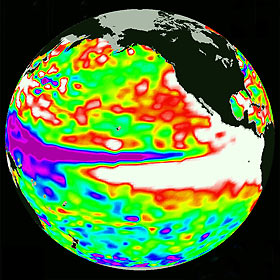
Save this image free of charge
in 800 pixels for layout use
(right click, Save as...)
|
|
Ref : V01872
Theme :
Earth in Space (419 images)
Title : TOPEX/El Nino Watch - Warm Water Pool is Increasing, Nov. 10, 1997
Caption :
This image of the Pacific Ocean was produced using sea surface height measurements taken by the U.S./French TOPEX/Poseidon satellite. The image shows sea surface height relative to normal ocean conditions on Nov. 10, 1997. The volume of extra warm surface water (shown in white) in the core of the El Nino continues to increase, especially in the area between 15 degrees south latitude and 15 degrees north latitude in the eastern Pacific Ocean. The area of low sea level (shown in purple) has decreased somewhat from late October. The white and red areas indicate unusual patterns of heat storage; in the white areas, the sea surface is between 14 centimeters and 32 cm (6 inches to 13 inches) above normal; in the red areas, it is about 10 centimeters (4 inches) above normal. The surface area covered by the warm water mass is about one-and-one-half times the size of the continental United States. The added amount of oceanic warm water near the Americas, with a temperature between 21- to- 30 degrees Celsius (70- to- 85 degrees Fahrenheit), is about 30 times the volume of water in all the U.S. Great Lakes combined. The green areas indicate normal conditions, while purple (the western Pacific) means at least 18 centimeters (7 inches) below normal sea level. The El Nino phenomenon is thought to be triggered when the steady westward blowing trade winds weaken and even reverse direction. This change in the winds allows a large mass of warm water (the red and white areas) that is normally located near Australia to move eastward along the equator until it reaches the coast of South America. The displacement of so much warm water affects evaporation, where rain clouds form and, consequently, alters the typical atmospheric jet stream patterns around the world.
|
|

